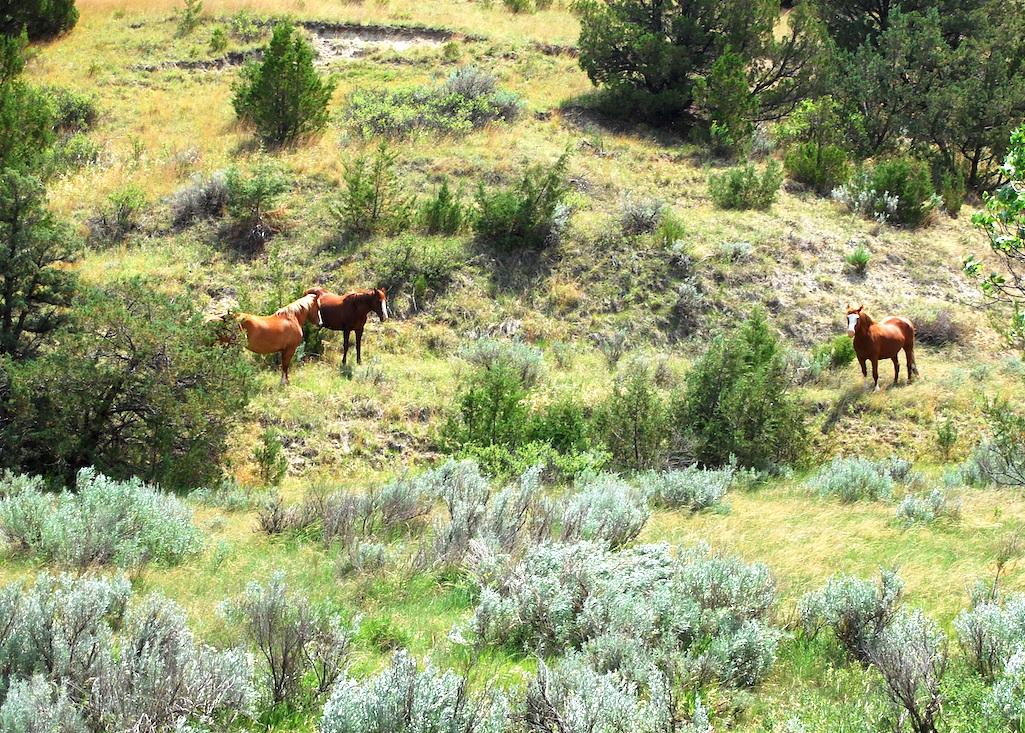
Should feral horses be removed from Theodore Roosevelt National Park?/Kurt Repanshek file
Op-Ed | Feral Horses Should Be Removed From Theodore Roosevelt National Park
By George Wuerthner
Theodore Roosevelt National Park has proposed eliminating feral horses and domestic livestock from the park. Unlike the fiasco at Point Reyes National Seashore, where the National Park Service appears to support maintaining domestic livestock within the park unit, the staff at Theodore Roosevelt recommends reducing the number of domestic animals to zero. Management of feral horses and domestic cattle across the West has been contentious for decades.
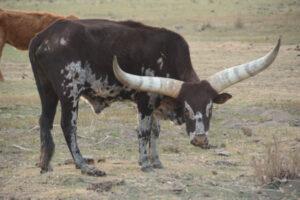
TRNP has a small herd of domestic cattle which it plans to eliminate/George Wuerthner
Opposition to the proposal comes from the Governor Burgum of North Dakota, the state Legislature, and the United Tribes of North Dakota. Burgum, speaking on behalf of the hospitality industry, suggests that horses and cattle are a draw for tourists and are part of the ranching “heritage” of the state.The state Legislature is also considering a resolution that would oppose the removal of livestock from the park. But, of course, this would only be advisory since federal authority trumps state laws.
The tribes, for their part, argue that horses are “sacred” and part of their cultural heritage.
Although the Park described the horses for decades as “wild horses” or “feral horses,” park officials recently classified them as livestock and maintain they have “no basis” to keep livestock in the park under laws and regulations.
Park officials, including Angie Richman, the park superintendent, have said the park’s enabling legislation and other federal laws don’t allow them to keep livestock in the park. The park’s mission, Richman has said, is to preserve native species and ecosystems.
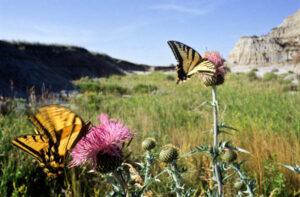
TRNP’s mission is to manage for prevation of natural values and biodivesity. Tiger swallowtail on thistle Theodore Roosevelt NP/George Wuerthner
The cattle management within the Park relies on a 1970s plan, while the feral horse plan was adopted in 1978. The 1978 plan called for 35-60 horses. Today there are more than 200, well above the original plan.
The Park has tried to limit the number of horses through periodic roundups and even birth control. But the horses, say the NPS, are “efficient breeders.”
The NPS says that based on new science, and ecological insights, the removal of horses and domestic cattle should be the priority of park management.
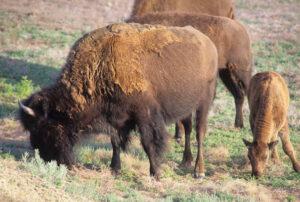
A new cattle borne disease poses a risk to the park bison herd/George Wuerthner
A further issue is that Theodore Roosevelt National Park is home to bison, and in 2022 a bacterial disease of cattle, Mycoplasma bovis, was discovered in the park. Mycoplasma bovis poses a threat to the park’s bison.
Three preliminary alternatives are under consideration by the National Park Service. Alternative A (No Action Alternative: continued herd management under the 1978 EA and 1970 Management Plan), Alternative B (Action Alternative: expedited reduction of herds to no livestock), and Alternative C (Proposed Action Alternative: phased reduction of herds to no livestock).
The expedited alternative would eliminate all horses and cattle within two years. Part of the reason for the quick removal of livestock is the risk of disease transfer they pose to the park’s bison herds.
However, since releasing a plan draft, feral horse and cattle advocates have rallied to flood the National Park Service with letters denouncing the move.
HISTORY OF THEODORE ROOSEVELT NATIONAL PARK
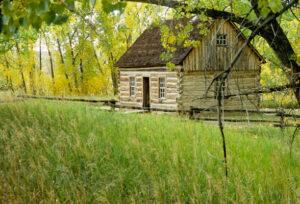
Theodore Roosvelt cabin Theodore Roosevelt NP/George Wuerthner
Theodore Roosevelt first came to ranch among the beautiful badlands along the Little Missouri River in North Dakota in 1884 after his mother died from typhoid fever and within hours his wife, Alice, also died from kidney disease.
Roosevelt was distraught; some say, he went west seeking solace over the loss of his family.
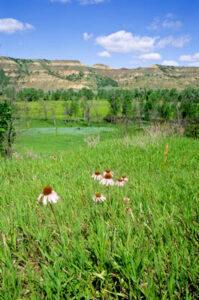
Prairie flowers in Theordore Roosevelt National Park/George Wuerthner
He established two ranches—the Maltese Cross Ranch near Medora and the Elkhorn some 35 miles north of Medora. After the devastating winter of 1886-87 that killed tens of thousands of cattle on the northern plains, Roosevelt decided to get out of the ranching business and focus on politics. He sold his last interests in the Elkhorn Ranch in 1898.
Theodore Roosevelt National Park was first proposed in 1919 shortly after TR died to honor the former President. However, it went nowhere until Franklin Roosevelt proposed in 1942 to add the area to the national park system.
In 1945 North Dakota Congressman William Lemke introduced a bill for a Little Missouri Badlands. But, unfortunately, it failed to get President Truman’s signature. So Lemke tried again in 1947 and got a Theodore Roosevelt Memorial Park managed mainly as a historical site.
Feral horses were present when the memorial Park was established in 1947.
In 1978, the area was upgraded to full national park status, and the NPS began to manage the site more for its natural values. The presence of exotic feral horses has never met the overriding principle of managing native species.
DO FERAL HORSES BELONG IN A NATIONAL PARK?
National Park Service Historian Robert Utley suggested that the horses have historical value and may be descendants of horses once bred by Sitting Bull and other native people.
Of course, all horses are descendants of domestic livestock, whether ridden by Roosevelt or Sitting Bull.
Feral horses are found on other national park units, such as Assateague Island National Seashore. And domestic cattle and horses are currently the subject of a controversial plan to maintain private farms within Point Reyes National Seashore. In addition, there are about 300,000 feral horses on the Bureau of Land Management and national forest lands and state, private and tribal lands across the West.
Many scientists believe feral horses pose a threat to native ecosystem, plants, and wildlife. However, feral horse advocates believe that domestic livestock pose a greater threat to the West’s ecosystems. However, the National Park Service has a different mandate than these other federal land management agencies. As noted by the Theodore Roosevelt National Park Superintendent, the Park Service’s mission is to preserve native species and ecosystems.
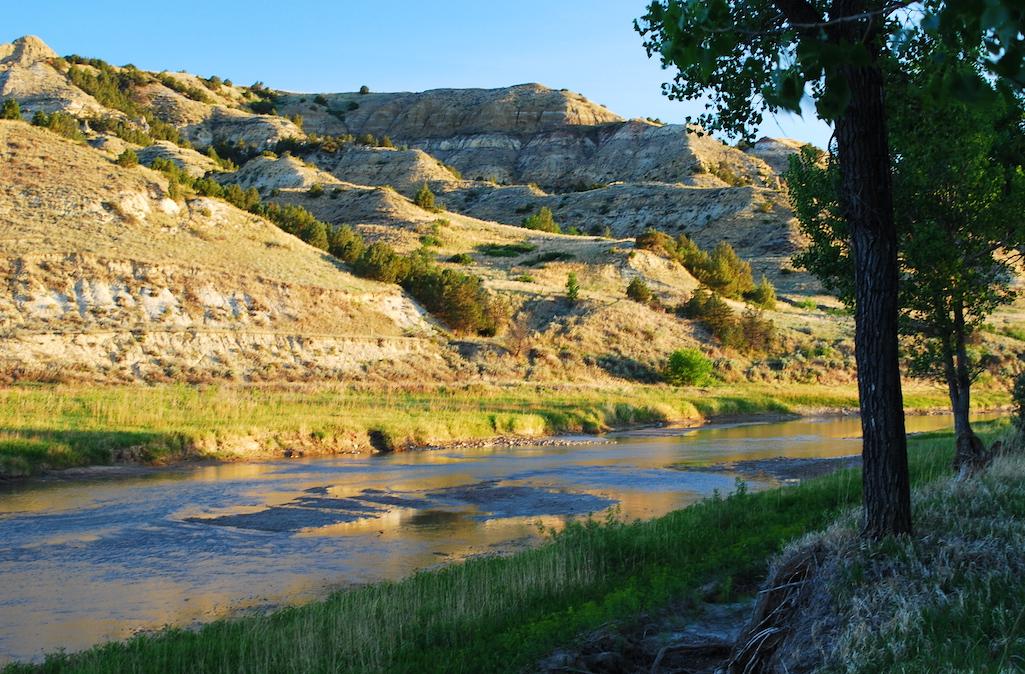
The NPS mission is to preserve the natural environment. Little Missouri River, Theodore Roosevelt National Park/Kurt Repanshek file
FERAL HORSES RELICTS OF SPANISH COLONIZATION
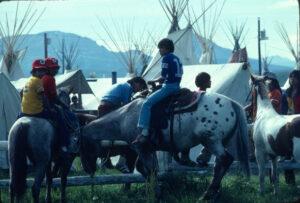
The cultural appropriation of the horse by Native Americans provided greater mobility, leading to more warfare, and the adoption of the bison hunting culture of the Great Plains/George Wuerthner
Horses are not native to North America and were introduced by the Spanish in 1519. Cultural appropriation by the tribes began in the 1600s. Horses reached tribes in the northern plains by 1750-1780, setting the era of mobile bison hunting tradition in motion. The adoption of the horse by Native Americans had both positive and negative influences for them. It also had severe consequences for bison herds, and tribal hunting for the hide trade may have contributed to the demise of the once vast bison herds.
This debate gets to the heart of the matter. Do we need to “preserve” domestic animals in our national parks?
Given that there are hundreds of thousands of feral horses, not to mention about 95 million domestic cattle in the United States, there is no need to keep either cattle or horses in any national park unit.
I commend Superintendent Richman and the Theodore Roosevelt National Park staff for having the courage to recommend removal of domestic animals from the park. However, with the pressure exerted on the Theodore Roosevelt National Park from North Dakota politicians, wild horse advocates, and the United Tribes of North Dakota who suggest feral horses are “sacred” animals, I suspect the National Park Service will bow to the political influence.
The Theodore Roosevelt National Park livestock management plan will be open for public comment later this spring and summer when park staff comes out with a finalized proposal.



Comments
If you want to play to nameblame game... Why do people use wild for fenced in FERAL horses? THERE ARE NO WILD HORSES ANYWHERE IN THE WORLD. THEY ARE PRODUCT OF being inbred / descendents of domesticate horses. We don't call feral cats / dogs wild... Why do people personify FERAL / wild animals?
The park is becoming overrun, I doubt Theodore Roosevelt will miss 1 visitor.
Hi Mike,
Do you have scientific proof the horses are degrading the habitat? I would really like to use that proof in an article I am working on!
Thank you so much!
Lucille
Neither the author nor most people commenting are familiar with the facts about the Theodore Roosevelt horses or why the NPS has kept them as a "demonstration herd" for over 60 years. It isn't as if the horses just showed up.
FIrst of all there is NO Scientific evidence that the horses are damaging the environment or pose a threat to other species there. Nor does the park pretend that there is any such data.
Second, the NPS allows horses in those rare cases when they are "managed as an integral part of the historic scene." This has been the case at Theodore Roosvelt Park for over 60 years.
As Robert Utley (chief historian for the entire NPS) noted the horses at Theodore Roosvelt Park are unique to the Little Missouri badlands and were there long before the park was established. Roosevelt and his contemporaries wrote about them, and it was the Marquis De Mores who purchased Lakota horses and raised them on the open range where the park is now sited. They have been considered an "historic demonstration herd" reflecting the open range ranchiing era of Roosevelt, which has long been an interpretive focus for the park. Roosevelt's presidential library is being built in the area.
The superintendent justifies plans to eliinate the herd because she says the park needs to support more than the 500 bison they already have, citing vague references to future climate change. She has also announced that the horses must go because the park is no longer interested in interpreting the history of the open range era, or Roosvelt's life as a rancher in the badlands (HISTORY is different from nostalgia). This has naturally aggrevated historians, some NPS professionals, and North Dakota officials , who consider regional and state history important.
Roosvelt himself said that he would not have been president if not for his experience ranching in North Dakota. His legacy is an important tourism draw in North Dakota and the wild horses are without doubt the single most popular feature among visitors to Theodore Roosevelt National Park, the states #1 attraction. That is why the state is fighting to keep the horses.
It is a mistake for the NPS to abandon local and regional history and to separate Roosevelts legacy as conservationist and rancher. Human activities and land use have to be part of broader conservation efforts. After interpreting Roosevelt's life as a rancher and the horses for 60+ years park management suddenly decided to make drastic changes and eliminate the herd, but they cannot cite any data or compelling reasons supporting these changes. Given the context it should not be surprising that the visiting public and state officals would protest those changes.
The horses are unique to the area and both the local community and park visitors feel strongly that they represnt the spirit of the Little Missouri badlands and that they are an irreplaceable link to previous generations. The NPS should reverse their decision and keep them there.
I'd also like to add that another article "The Key to the Feral Horse Issue at TRNP is a Natural Ecosystem," published here on March 8, 2023 cites the superintendent as saying that M.Bovis is NOT an issue there although it has been found on other public lands in the greater Plains region. I could find no source on M. Bovis being found at TRNP other than Wuerthner's claim in this OP-ED.
The author also dismisses the claim of NDakota's tribes that the horses should stay because they believe that they are "sacred." The land that now hosts the park was TRIBAL land-claimed by both Lakotas and the Mandan, Hidatsa and Arikara. In recent decades the NPS has made an effort to recognize tribal perspectives and legacies and they work closely with ND tribes regarding bison and are obliged to consult with tribes regarding their management policies and actions.
The NPS has also increasingly made efforts to recognize both cultural history and natural history and to incorporate local community voices and stories. While preserving native ecosystems is very important, it is impossible to return park areas to a mythical "pristine" state, and cooperation and collaboration with state and local people is vital to the future of NPS. And there are valid reasons to question whether the horses at TRNP are damaging the park environment.
TRNP is not an arid area like Nevada, or a BLM area that also hosts domestic cattle (the few longhorns are steers) nor is it a wetland habitat such as Cumberland Island; it is a Plains grassland. Grazing is part of such ecologies and many scientisits consider horses to be native species since the entire genus Equus evolved in North America and E.Caballus was not gone for long. Some archaeologists claim to have found evidence of post-Pleistocene horses in North America, and if that data proves reliable the window is even more narrow.
The governor of North Dakota has offered to work WITH the NPS to find a way for the park to maintain the horses, and has suggested that ND universitites can contribute by conducting actual empirical studies of how the horses impact the environment, and find ways to help the park with managemnt so that the horses do not drain scarce rsources. That seems very reasonable to me, and even innovative, but the author chose not to include it in his diatribe.
My point is that the author throws a lot of generalizations and verbage at this issue instead of addressing the specific situation and context, and omits several key issues.